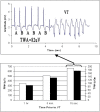Spectrum of clinical applications of interlead ECG heterogeneity assessment: From myocardial ischemia detection to sudden cardiac death risk stratification
- PMID: 34592018
- PMCID: PMC8588374
- DOI: 10.1111/anec.12894
Spectrum of clinical applications of interlead ECG heterogeneity assessment: From myocardial ischemia detection to sudden cardiac death risk stratification
Abstract
Heterogeneity in depolarization and repolarization among regions of cardiac cells has long been recognized as a major factor in cardiac arrhythmogenesis. This fundamental principle has motivated development of noninvasive techniques for quantification of heterogeneity using the surface electrocardiogram (ECG). The initial approaches focused on interval analysis such as interlead QT dispersion and Tpeak -Tend difference. However, because of inherent difficulties in measuring the termination point of the T wave and commonly encountered irregularities in the apex of the T wave, additional techniques have been pursued. The newer methods incorporate assessment of the entire morphology of the T wave and in some cases of the R wave as well. This goal has been accomplished using a number of promising vectorial approaches with the resting 12-lead ECG. An important limitation of vectorcardiographic analyses is that they require exquisite stability of the recordings and are not inherently suitable for use in exercise tolerance testing (ETT) and/or ambulatory ECG monitoring for provocative stress testing or evaluation of the influence of daily activities on cardiac electrical instability. The objectives of the present review are to describe a technique that has been under clinical evaluation for nearly a decade, termed "interlead ECG heterogeneity." Preclinical testing data will be briefly reviewed. We will discuss the main clinical findings with regard to sudden cardiac death risk stratification, heart failure evaluation, and myocardial ischemia detection using standard recording platforms including resting 12-lead ECG, ambulatory ECG monitoring, ETT, and pharmacologic stress testing in conjunction with single-photon emission computed tomography myocardial perfusion imaging.
Keywords: ECG heterogeneity; T-wave alternans; heart failure; myocardial ischemia; sudden cardiac death risk stratification; ventricular arrhythmias.
© 2021 Wiley Periodicals, Inc.
Conflict of interest statement
The authors declare no conflicts of interest in connection with this article. No funds were received for the preparation of this review.
Figures









Similar articles
-
Tracking interlead heterogeneity of R- and T-wave morphology to disclose latent risk for sudden cardiac death.Heart Rhythm. 2017 Oct;14(10):1466-1475. doi: 10.1016/j.hrthm.2017.06.017. Epub 2017 Jun 10. Heart Rhythm. 2017. PMID: 28610987 Review.
-
Ambulatory ECG-based T-wave alternans monitoring for risk assessment and guiding medical therapy: mechanisms and clinical applications.Prog Cardiovasc Dis. 2013 Sep-Oct;56(2):172-85. doi: 10.1016/j.pcad.2013.07.002. Epub 2013 Sep 21. Prog Cardiovasc Dis. 2013. PMID: 24215749
-
Noninvasive sudden death risk stratification by ambulatory ECG-based T-wave alternans analysis: evidence and methodological guidelines.Ann Noninvasive Electrocardiol. 2005 Jan;10(1):110-20. doi: 10.1111/j.1542-474X.2005.10103.x. Ann Noninvasive Electrocardiol. 2005. PMID: 15649246 Free PMC article. Review.
-
Electrocardiographic conduction and repolarization markers associated with sudden cardiac death: moving along the electrocardiography waveform.Minerva Cardioangiol. 2019 Apr;67(2):131-144. doi: 10.23736/S0026-4725.18.04775-8. Epub 2018 Sep 26. Minerva Cardioangiol. 2019. PMID: 30260143 Review.
-
[Heterogeneities of ventricular repolarization and vulnerability to arrhythmia. How to detect them with noninvasive methods?].Cardiologia. 1999 Apr;44(4):355-60. Cardiologia. 1999. PMID: 10371787 Review. Italian.
Cited by
-
Reduction in atrial and ventricular electrical heterogeneity following pulmonary vein isolation in patients with atrial fibrillation.J Interv Card Electrophysiol. 2025 Mar;68(2):335-346. doi: 10.1007/s10840-023-01543-7. Epub 2023 Apr 19. J Interv Card Electrophysiol. 2025. PMID: 37074510
-
Biomechanical Sensing Systems for Cardiac Activity Monitoring.Int J Biomater. 2022 Nov 18;2022:8312564. doi: 10.1155/2022/8312564. eCollection 2022. Int J Biomater. 2022. PMID: 36438068 Free PMC article. Review.
-
Machine learning derived ECG risk score improves cardiovascular risk assessment in conjunction with coronary artery calcium scoring.Front Cardiovasc Med. 2022 Oct 5;9:976769. doi: 10.3389/fcvm.2022.976769. eCollection 2022. Front Cardiovasc Med. 2022. PMID: 36277775 Free PMC article.
-
Digital Electrocardiographic Complex for Risk Stratification of Paroxysmal Atrial Fibrillation.Sovrem Tekhnologii Med. 2024;16(3):43-48. doi: 10.17691/stm2024.16.3.05. Epub 2024 Jun 28. Sovrem Tekhnologii Med. 2024. PMID: 39650275 Free PMC article.
-
Continuous multi-day tracking of post-myocardial infarction recovery of cardiac electrical stability and autonomic tone using electrocardiogram patch monitors.Ann Noninvasive Electrocardiol. 2023 Jan;28(1):e13035. doi: 10.1111/anec.13035. Ann Noninvasive Electrocardiol. 2023. PMID: 36630149 Free PMC article.
References
-
- Araujo Silva, B. , Hauser, T. H. , Nearing, B. D. , Bortolotto, A. L. , Marum, A. A. , Tessarolo Silva, F. , Medeiros, S. A. , Pedreira, G. C. , Gervino, E. V. , & Verrier, R. L. (2020). Regadenoson‐induced T‐wave heterogeneity complements coronary stenosis detection by myocardial perfusion imaging in men and women. European Heart Journal ‐ Cardiovascular Imaging, jeaa128. 10.1093/ehjci/jeaa128 - DOI - PubMed
-
- Bonatti, R. , Silva, A. F. G. , Batatinha, J. A. P. , Sobrado, L. F. , Machado, A. D. , Varone, B. B. , Nearing, B. D. , Belardinelli, L. , & Verrier, R. L. (2014). Selective late sodium current blockade with GS‐458967 markedly reduces ischemia‐induced atrial and ventricular repolarization alternans and ECG heterogeneity. Heart Rhythm, 11(10), 1827–1835. 10.1016/j.hrthm.2014.06.017 - DOI - PubMed
-
- Bortolotto, A. L. , Verrier, R. L. , Nearing, B. D. , Marum, A. A. , Araujo Silva, B. , Pedreira, G. C. , Tessarolo Silva, F. , Medeiros, S. A. , Sroubek, J. , Zimetbaum, P. J. , & Chang, J. D. (2020). Pre‐implantation interlead ECG heterogeneity is superior to QRS complex duration in predicting mechanical super‐response in patients with non‐left bundle branch block receiving cardiac resynchronization therapy. Heart Rhythm, 17(11), 1887–1896. 10.1016/j.hrthm.2020.05.036 - DOI - PubMed
-
- Burke, G. M. , Araujo Silva, B. , Marum, A. A. , Bortolotto, A. L. , Nearing, B. D. , Chen, M .J. , Fostello, S. , Popma, J. J. , Verrier, R. L. , & Chang, J. D. (2021). Speckle tracking strain and ECG heterogeneity correlate in transcatheter aortic valve replacement‐Induced left bundle branch blocks and right ventricular paced rhythms. Open Heart, in press. - PMC - PubMed
Publication types
MeSH terms
LinkOut - more resources
Full Text Sources
Miscellaneous

